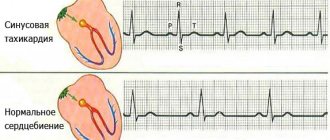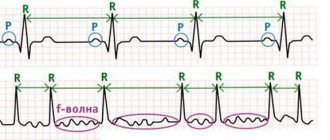Formation time
As a rule, fetal heartbeat appears within 30 days after successful implantation. The fact is that of all organs, the heart is one of the first to form. Its formation occurs already from 21 days after conception. At 3-4 weeks, the heart muscle is a small hollow tube, which, however, is already capable of contraction. It becomes a full-fledged four-chamber organ at the 8th week of pregnancy.
To hear the heartbeat, a woman needs to visit an ultrasound specialist.
Note!
Heart rate can only be determined in the early stages using a transvaginal sensor.
Starting from the third month of pregnancy, examinations can already be performed abdominally.
The number of contractions during normal childbearing should be at least 80-100
and no more than 200 in one minute.
The time when the fetal heart begins to beat is usually the same for all women.
However, if at the first ultrasound it was not possible to hear it, but the fertilized egg in the uterus is visualized, you should not get upset prematurely.
The fact is that the period of conception may be set incorrectly and the heart muscle has not yet had time to fully form
.
The doctor will definitely prescribe a repeat test in 7-14 days. When the fetal heartbeat is heard on an ultrasound, we can confidently say that the pregnancy is not frozen.
It is worth noting that during the first ultrasound examination, the doctor may not hear what kind of heartbeat the embryo has if the study is performed on an old device. Therefore, it is best for a woman to go to a good clinic with high-quality medical equipment and experienced specialists.
At what hCG level can you hear a heartbeat? As a rule, in the middle of the second month after implantation, the level of human chorionic gonadotropin reaches 7200 IU/l. With this indicator, you can already see the fertilized egg in the uterine cavity, and distinguish the beating of the heart muscle that is not yet fully formed. Knowing at what hCG the heartbeat is heard, you can choose the right day to visit a doctor who, using modern equipment, will confirm pregnancy.
It is important to measure heart rate during the first trimester
. The fact is that it is in the first three months that congenital defects can occur in the embryo. As a rule, pathology appears due to the bad habits of the expectant mother, taking antibiotics, hereditary predisposition, severe stress and infectious diseases.
To try to prevent abnormal heart development in a child, it is recommended to plan conception
in advance. A few months before pregnancy, you should completely get rid of bad habits, stop taking medications that can be toxic to the baby, eliminate coffee and tea from your diet, and try not to be nervous or worry about anything.
Why may you not hear a heartbeat, what to do if there are deviations from the norm?
Sometimes some violations are heard that do not correspond to the generally accepted norm. Additional examinations are prescribed to determine the factors that caused negative deviations. Some of them provoke a rapid heartbeat, others cause a slow pace.
Reasons for causing the rhythm to be too fast (more than 200 beats/min):
- presence of anemia;
- low hemoglobin level in a child;
- placental insufficiency, disturbance of uterine blood flow;
- placental abruption causing bleeding;
- inflammatory processes in the amniotic membranes;
- high intracranial pressure, fetal hypoxia.
Taking certain medications by a pregnant woman and the presence of a high temperature in the expectant mother can influence an increase in the child’s heart rate.
Factors leading to slow beating:
- high potassium content in maternal blood, which can cause bradycardia;
- a pregnant woman lying on her back for a long time (for example, for medical reasons), which causes compression of the inferior vena cava;
- formation of a knot on the umbilical cord or its compression.
Sometimes the rhythm is not heard.
If this is observed in the first 3 months of pregnancy, which happens most often, then the doctor diagnoses a non-developing pregnancy.
When undergoing an ultrasound, situations are possible when the presence of a fertilized egg is detected, but there is no heartbeat, which indicates the absence of an embryo (it died much earlier), and this is called “anembryony.”
The absence of strokes in the later stages (by the 19th week) indicates intrauterine death of the fetus, which is the reason for artificial birth.
Measurement methods
Fetal heart rate is measured using modern hardware methods
, which include
- Ultrasound is one of the most common ways to determine the duration of pregnancy, the size of the baby, examine the heart muscle and listen to its tones. You can listen to the frequency of contractions on an ultrasound examination as early as 5-7 obstetric weeks
. When the fetal heartbeat is heard on an ultrasound for the first time, the woman feels true happiness, since she is now sure that the baby is developing normally. - A stethoscope is a medical device that can be used not only by specialists, but also by people without medical education. A stereoscope can be used closer to the third trimester.
- Cardiography to determine whether the heart muscle is working properly. With high accuracy, this method can detect oxygen starvation, thanks to which the doctor has the opportunity to take the necessary measures in a timely manner. The first time CTG is performed in the middle of the third trimester .
Cardiography may be prescribed earlier.
This is done if other hardware examination methods have given questionable results. - Echocardiography is one of the highly informative methods of ultrasound examination. Echocardiography is prescribed at 18-28 weeks
if the doctor suspects that the embryo has developed a heart muscle defect.
Each of the above methods is informative and highly accurate. Hardware research methods not only make it possible to calculate the fetal heartbeat by week, but also to promptly identify abnormalities in the development of the embryo.
Is it possible to hear the fetal heartbeat on your own?
If the expectant mother has a desire to listen to the heart of her baby, then it is not necessary to make an extraordinary visit to the antenatal clinic. There are several ways to listen to the sound of life developing.
Stethoscope
Auscultation with an obstetric stethoscope is accessible to absolutely everyone. This requires an obstetric tube (which costs very little) and an attentive and patient assistant. If he is not a doctor, then it is unlikely that he will be able to hear the heart before the 25th week of pregnancy.
The main thing is daily training. Then one fine day a husband, mother or other owner of a stethoscope will be able to hear the long-awaited sounds of a heartbeat. It is important to learn to distinguish them from the sounds of fetal movement, pulse or peristalsis of the mother.
Fetal Doppler - heartbeat detector
If you don’t have time to train in auscultation, you can purchase a portable ultrasound detector - a fetal doppler. This device works on the principle of a conventional CTG machine, but does not write a graphic image on film. Often, headphones are included with the device for comfortable listening. You can hear the heartbeat with this device as early as 8-12 weeks, but doctors recommend using it much later, when necessary, the study should last no more than 10 minutes.
| Pros of a portable doppler: | Disadvantages of a portable doppler: | |
|
Despite the safety of Doppler, you need to observe moderation in everything and not use the device often and for a long time |
Putting your ear to your stomach
When can you hear the fetal heartbeat in your ear? In late pregnancy (after 30 weeks), you can make sure that the fetal heartbeat is normal by simply placing your ear to the pregnant woman’s stomach, but it depends on the woman’s fat layer. You need to listen to the baby's heart in a certain place in the abdomen, depending on the location of the fetus in the uterus. If the baby lies head down, then his heart is better heard below the woman’s navel, from the side of the baby’s back. With a breech presentation, it is better to listen to tones above the navel. If the pregnancy is multiple, then the heart of each child can be heard in different parts of the abdomen.
Cases of serious pathologies causing heartbeat disturbances are quite rare. Nature has decreed that the vast majority of pregnancies end in the birth of an absolutely healthy and full-fledged child. Therefore, in parallel with observation by a doctor, you need to listen to the life emerging inside and rejoice in future motherhood.
Author:
Evtushenko Anna Aleksandrovna obstetrician-gynecologist
Can you feel the beat through your stomach?
Regardless of the stage of pregnancy, a woman cannot feel
the heartbeat of her unborn baby.
What she mistakes for heartbeats is only the pulsation of her own aorta, which occurs as a result of increased pressure in this vessel.
A surge in blood pressure occurs due to serious hormonal changes occurring in the female body.
If a woman feels through her stomach
something similar to a heartbeat, it is imperative to contact a gynecologist, who, after a thorough examination, can refer her for a consultation with an experienced cardiologist.
Is it possible to hear the fetal heartbeat yourself at home? It is quite difficult to do this without the help of specialized medical equipment. Fortunately, today you can purchase devices that will allow you to hear the heartbeat of your long-awaited and already beloved baby already in the third trimester.
How can you listen to the beat yourself?
If you are interested in how to listen to the fetal heartbeat at home, you should know that in the early stages it is impossible to do this on your own.
In the first and second trimesters, this can only be done by a specialist using special equipment.
Popular methods for listening to the fetal heartbeat at home:
- Fetal Doppler, which can be used from the second trimester. This ultrasonic detector provides fairly accurate results. However, the cost of such a device is high.
- Starting from the third trimester, the expectant mother can independently listen to the baby’s heartbeat using a stethoscope.
However, in some cases this cannot be done. For example, hearing the beat frequency may be difficult due to the mother's thick abdominal fat or large volume of amniotic fluid.
All of the above devices are absolutely harmless to the embryo. However, the baby often feels the radiation emanating from the device and always tries to move away from its rays. If a woman feels the baby is restless, it is best to postpone the measurement until the baby calms down. The measurement time should not exceed 10 minutes.
Longer use of the device causes stress in the child.
Determination of the listening location
Before performing independent auscultation, you need to determine how the baby is positioned relative to the midline of its mother’s abdomen.
Using your palms, smoothly, gently, but with a certain degree of pressure, evaluate which part is above the womb. The hands are closed at the tips of the middle fingers, the palmar surface of the hands is facing the pregnant woman’s face, and the back is facing the legs.
In this position, the phalanges are slightly immersed, palpating what is located in the lower abdomen (head or pelvis, legs of the fetus). Then continue palpation, moving upward.
The convex dense part corresponds to the back. It is in this area that the phonendoscope membrane must be installed.
Norm
The frequency of the rhythms directly depends on the period of gestation of the child. Modern doctors have established the normal heart rate
fetus by week, which allows you to control the development of the embryo.
The fetal heart rate by week is presented in the following table.
| Week no. | Heart rate, min |
| 4-5 | 80-85 |
| 6 | 100-130 |
| 7 | 110-130 |
| 8 | 150-170 |
| 9-10 | 170-190 |
| Starting from 11th | 140-160 |
Why is it important to know what the normal fetal heart rate is by week?
The fact is that when you see deviations in the child’s heart rate in a timely manner, you can warn
spontaneous miscarriage and the development of a dangerous illness in the embryo.
However, with a slight deviation, the diagnosis is usually not made.
Beating too
heart in the embryo may be associated with:
- Severe stress experienced by the expectant mother.
- Chronic hypoxia.
- Lack of oxygen
in rooms where the expectant mother often spends her time. - Anemia.
A mandatory point during childbirth is to measure the baby’s heart rate, since during delivery the baby experiences severe stress and lack of oxygen. The beating rate is 140 beats per minute.
However, in some cases this figure can reach 160.
Important!
By monitoring the frequency of contractions, the doctor can determine when placental abruption occurs or notice compression of the umbilical cord.
Useful video: fetal heartbeat by week
When should you calculate your heart rate?
Tracking the number of heartbeats is required not only for aesthetic pleasure, but also for this process there is a certain necessity.
Among the situations in which it is necessary to constantly monitor the baby’s heartbeat, the following can be noted:
- Bloody discharge, and at different times . The cause of such a problem can be placental abruption, therefore strict control over the general condition of the fetus is required throughout pregnancy.
- Increased uterine tone . In this position, the blood vessels of the placenta are quite strongly compressed, which often leads to disturbances in the process of blood circulation and heartbeat. The child in such a situation does not receive enough nutrition and oxygen.
- If there is a threat of miscarriage , it is also very important to monitor the fetal heartbeat. If you notice even the slightest signs of a malfunction, you should immediately seek qualified medical help.
- You need to monitor your heart rate if your mother has a decrease in hemoglobin levels . In this case, the baby does not receive the required amount of oxygen and nutritional components necessary for full development, which are usually carried through the blood.
An examination of this kind is a necessity for all mothers who have pathologies that can cause a lack of oxygen and beneficial microelements.
Conclusion
Thus, at 5-7 weeks of pregnancy, when the fetal heart begins to beat, you can begin to monitor the development of the unborn child. The fetal heart rate should be measured throughout the entire period of waiting for the baby and even during labor. Thanks to regular visits to the doctor and knowledge of what week the heartbeat appears, you can promptly prevent spontaneous miscarriage and the appearance of any pathology in the embryo. Find out which thermometer to measure basal temperature using this link.











